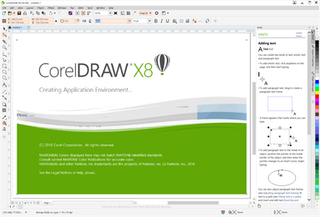
The LaserWriter is a laser printer with built-in PostScript interpreter sold by Apple, Inc. from 1985 to 1988. It was one of the first laser printers available to the mass market. In combination with WYSIWYG publishing software like PageMaker, that operated on top of the graphical user interface of Macintosh computers, the LaserWriter was a key component at the beginning of the desktop publishing revolution.
Desktop publishing (DTP) is the creation of documents using dedicated software on a personal ("desktop") computer. It was first used almost exclusively for print publications, but now it also assists in the creation of various forms of online content. Desktop publishing software can generate page layouts and produce text and image content comparable to the simpler forms of traditional typography and printing. This technology allows individuals, businesses, and other organizations to self-publish a wide variety of content, from menus to magazines to books, without the expense of commercial printing.

Adobe Illustrator is a vector graphics editor and design program developed and marketed by Adobe Inc. Originally designed for the Apple Macintosh, development of Adobe Illustrator began in 1985. Along with Creative Cloud, Illustrator CC was released. The latest version, Illustrator 2024, was released on October 10, 2023, and is the 28th generation in the product line. Adobe Illustrator was reviewed as the best vector graphics editing program in 2021 by PC Magazine.

Macromedia, Inc., was an American graphics, multimedia, and web development software company (1992–2005) headquartered in San Francisco, California, that made products such as Flash and Dreamweaver. It was purchased by its rival Adobe Systems on December 3, 2005.

Adobe PageMaker is a desktop publishing computer program introduced in 1985 by the Aldus Corporation on the Apple Macintosh. The combination of the Macintosh's graphical user interface, PageMaker publishing software, and the Apple LaserWriter laser printer marked the beginning of the desktop publishing revolution. Ported to PCs running Windows 1.0 in 1987, PageMaker helped to popularize both the Macintosh platform and the Windows environment.

Clip art is a type of graphic art. Pieces are pre-made images used to illustrate any medium. Today, clip art is used extensively and comes in many forms, both electronic and printed. However, most clip art today is created, distributed, and used in a digital form. Since its inception, clip art has evolved to include a wide variety of content, file formats, illustration styles, and licensing restrictions. It is generally composed exclusively of illustrations, and does not include stock photography.
A number of vector graphics editors exist for various platforms. Potential users of these editors will make a comparison of vector graphics editors based on factors such as the availability for the user's platform, the software license, the feature set, the merits of the user interface (UI) and the focus of the program. Some programs are more suitable for artistic work while others are better for technical drawings. Another important factor is the application's support of various vector and bitmap image formats for import and export.

Silicon Beach Software, Inc., was an early American developer of software products for the Macintosh personal computer. It was founded in San Diego, California, in 1984 by Charlie Jackson and his wife Hallie. Jackson later co-founded FutureWave Software with Jonathan Gay. FutureWave produced the first version of what is now Adobe Flash. Although Silicon Beach Software began as a publisher of game software, it also published what was called "productivity software" at the time.
Altsys Corporation was a Texas-based software company founded by James R. Von Ehr II. It was an early Apple Macintosh developer and publisher.

SuperPaint is a graphics program capable of both bitmap painting and vector drawing. SuperPaint was one of the first programs of its kind, combining the features of MacPaint and MacDraw while adding many new features of its own.
Bruce R. Chizen is an American technology executive. He was the chief executive officer (CEO) of Adobe Systems from 2000 to 2007.

Paul Brainerd is an American businessman, computer programmer and philanthropist. In 1984, he co-founded the Aldus Corporation, which released Pagemaker, the first consumer-use desktop publishing software. Brainerd has since coined the term "desktop publishing". Since 1995, he has been involved in philanthropic efforts, including the founding of Social Ventures Partners in 1997, a global organization that connects local investors with non-profit community organizations.
Digital Darkroom was an Apple Macintosh graphics program for editing gray-scale photos. It was published by Silicon Beach Software in 1987. It was programmed by Ed Bomke and Don Cone.
FutureWave Software, Inc was a software development company based in San Diego, California. The company was co-founded by Charlie Jackson and Jonathan Gay on January 22, 1993. VP of Marketing was Linda Michelle Alsip, who also came from Silicon Beach Software, then Aldus Corporation.
Jonathan Gay is an American computer programmer and software entrepreneur based in Northern California. Gay co-founded FutureWave Software in 1993. For a decade, he was the main programmer and visionary of Flash, an animation editor for web pages. He founded Software as Art, which was later renamed Greenbox, which made energy management solutions for the home.
MacPublisher was the first Desktop Publishing program for the Apple Macintosh, introduced in 1984, the same year that Apple introduced the Macintosh. DTP competitors Ready, Set, Go! and Aldus PageMaker were introduced in 1985 when Apple delivered the 512K Macintosh.

CorelDRAW is a vector graphics editor developed and marketed by Alludo. It is also the name of the Corel graphics suite, which includes the bitmap-image editor Corel Photo-Paint as well as other graphics-related programs. It can serve as a digital painting platform, desktop publishing suite, and is commonly used for production art in signmaking, vinyl and laser cutting and engraving, print-on-demand and other industry processes. Reduced-feature Standard and Essentials versions are also offered.

Adobe FreeHand is a discontinued computer application for creating two-dimensional vector graphics oriented primarily to professional illustration, desktop publishing and content creation for the Web. FreeHand was similar in scope, intended market, and functionality to Adobe Illustrator, CorelDRAW and Xara Designer Pro. Because of FreeHand's dedicated page layout and text control features, it also compares to Adobe InDesign and QuarkXPress. Professions using FreeHand include graphic design, illustration, cartography, fashion and textile design, product design, architects, scientific research, and multimedia production.








